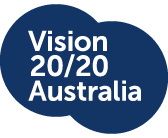On Monday 23rd June, I was lucky enough to attend the National Aboriginal and Torres Strait Islander Eye Health Coordination Forum; presented by Brien Holden Vision Institute in partnership with National Aboriginal Community Controlled Health Organisation (NACCHO) and Vision 2020 Australia. In keeping with the theme of the NACCHO Summit taking place later in the week, representatives of a diverse range of service provider organisations from across Australia arrived with the intent to share knowledge and information. All attendees were prepared to discuss the challenges and successes faced while providing eye care services for Aboriginal and Torres Strait Islander people across their different regions.
Lisa Briggs, CEO of NACCHO, opened the day by highlighting the urgency of defining the gaps in eye care services across the country. She emphasised the need to keep eye care and vision loss among Aboriginal and Torres Strait Islander people on the national agenda and stressed that the accounts of eye care services providers on the ground could do this in an incredibly powerful way.
A common thread
Representatives from each state and territory presented to the wider group regarding their aims and current programs as well as lessons learned. Apparent throughout these presentations were the many common struggles across each state and territory. These included a striking lack of stable and ongoing funding, the travel costs and logistics involved in covering incomprehensibly large distances and the flexibility and adaptability required when engaging with the Aboriginal and Torres Strait islander culture.
Anecdotal evidence from all represented organisations highlighted the challenges they faced but also the successes achieved in responding to these challenges. The passion and dedication of each person in the room was palpable as they debated the best approaches to problems faced, shared lessons learned and celebrated astounding successes. The innovative ideas from individuals on the ground were awe inspiring; from combining different program funding streams in order to stretch the dollars that little bit further to providing impromptu dances and sing-alongs in waiting rooms in order to retain clients–the flexibility and adaptability of service providers was apparent at each turn.
Looking forward
The second part of the day was based around leading research and advocacy bodies sharing with those on the ground what they had been doing over the last 12 months. Brandon Ah Tong from Vision 2020 Australia gave a brief overview of the National framework implementation plan (NFIP), the proposed National eye health survey and advocacy efforts around attaining a national Subsidised Spectacle Scheme similar to that currently in Victoria. David Morgan, Chief Operations Officer of the Lowitja Institute then gave a quick explanation of the Institute, outlining their research priorities and introducing their new Cooperative Research Centre (CRC). Mr Morgan implored attendees to help guide the research direction for the new CRC. He advised that by putting forward research proposals around investigating the Aboriginal and Torres Strait Islander healthcare service; the Lowitja Centre could assist in determining successful methods of eye care provision. Chris Poulter from Optometry Australia outlined the key principles of their advocacy efforts for a national Subsidised Spectacle Scheme. Finally, Mitchell Anjou from the Indigenous Eye Health Unit (IEHU) at the University of Melbourne presented the Roadmap to Close the Gap for Vision, discussed the Victorian Aboriginal Subsidised Spectacles Scheme (VASSS) and gave an introduction to IEHU’s calculator for defining the gap between what eye care services are currently taking place and what is required in order to close the gap.
The National Aboriginal and Torres Strait Islander Eye Health Coordination Forum overall was a beneficial event for all involved. Eye health coordinators on the ground across Australia were able to share knowledge and information about what their successes as well as discuss their lessons learned in order to assist other programs to maximise effectiveness. There were a number of tools encouraged by organisations in the advocacy space including the IEHU Eye Care Services calculator, and a request for research proposals from the Lowitja institute. By the end of the day, the group were enthusiastically sharing ideas in order to create an all-inclusive position on what was required for programs to remain sustainable. As a group, their aim was to be able to continue providing stable and long-term program and personnel support, acknowledging that 94 per cent of vision loss in Aboriginal and Torres Strait Islander people is preventable.
